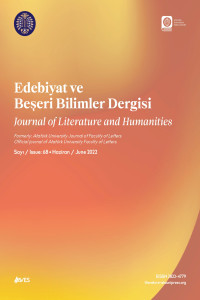SANSÜRÜN ÇEVİRİDE İŞLEYİŞİ VE PATRONAJ/The Function of Censorship in Translation and Patronage
ÖzBu çalışmanın amacı, Arthur Koestler’in Darkness at Noon (1941/2006) adlı metni metnini “sansür” bağlamında ele alarak hem patron hem de çevirmen olmanın çeviri metne nasıl yansıyabileceğini “patronaj” kavramı üzerinden tartışmaktır. Kaynak metin, metinsel ve yan-metinsel unsurlar açısından değerlendirilecektir. Kuramsal çerçevede öncelikli olarak “çevride sansür” olgusu çeşitli yönleriyle irdelenecektir. Sansür çeviride stratejik bir unsur olarak metinlerden belli bölümlerin çıkarılması, değiştirilmesi veya metinlere eklenmeler yapılması, metinlerin tamamen değiştirilmesi, hiç yayınlanmaması ya da yayınlandıktan sonra toplatılması gibi birbirinden farklı uygulamalar aracılığıyla gerçekleşebilir. Kuramsal çerçevede ayrıca, çeviride ideoloji ve yönlendirme gibi unsurların varlığına dikkat çeken çeviribilimci André Lefevere’in ortaya koyduğu “patronaj” kavramı üzerinde durulacaktır. Patronaj, yazının okunmasını, yazılmasını, yönlendirilmesini ve yeniden yazılmasını destekleyen veya baltalayan birey ya da herhangi bir kurum ve kuruluşu kapsayan bir kavramdır ve çeviride etkin bir araç olarak nitelendirilebilir. Bu doğrultuda, çalışma çeviride sansürün çok yönlü doğasına ışık tutmaya ve patron-çevirmenlerin çeviride uygulayabilecekleri “patronajı” örneklendirmeye çalışacaktır.Anahtar Sözcükler: Çeviride Sansür, Patronaj, Çevirmen, Patron, Erek MetinAbstractThe aim of this study is to examine Arthur Koestler’s novel Darkness at Noon (1941/2006) and its target text within the context of “censorship” and discuss how being both a translator and patron reflect on the translated text on the basis of “patronage” concept. The source text and the target text will be evaluated in terms of textual and paratextual elements. As a strategic element, censorship can be carried out through different applications such as omission of certain parts from texts, changings or additions in texts, changing the whole body of texts, not publishing or recalling texts from market. As a part of theoretical framework, the concept of “patronage” put forward by André Lefevere who pointed out the existence of elements such as “ideology” and “manipulation” in translation. Thus, this study will try to shed light on the multi-dimensional nature of censorship in translation and exemplify “patronage” that patron-translators may apply in translation.Keywords: Censorship in Translation, Patronage, Translator, Patron, Target Text.
Anahtar Kelimeler:
Çeviride Sansür, Patronaj, Çevirmen, Patron
___
- Arslan, Devrim Ulaş. (2016). Translation, Obscenity and Censorship in Turkey: Avni İnsel as a Translator and Patron of Popular Erotic Literature. Yayınlanmamış Yüksek Lisans Tezi. Dokuz Eylül Üniversitesi, İzmir.
- Avşaroğlu, Merve. (2014).Translation as a Norm-breaking Activity: A Case- Study on the Turkish Translation of Marjorie Housepian Dobkin’s "Smyrna 1922 The Destruction of a City". Yayınlanmamış Yüksek Lisans Tezi. Hacettepe Universitesi, Ankara.
- Barut, Evren; Odacıoğlu, Mehmet.; Köktürk, Şaban. (2016). “Sovyet Sosyalist Cumhuriyetler Birliği’nde (SSCB) Düşünce Hareketlerinin Edebi Eserler Üzerinde Etkisi: SSCB’de Çeviri Sansürü. Tarih Okulu Dergisi (TOD), Yıl 9 Sayı XXVI, s. 459-479.
- Ben-Ari, Nitsa. (2010).“When Literary Censorship is not Strictly Enforced, Self-Censorship Rushes In”. TTR: Traduction, Terminologie, Rédaction. 23(2), s. 133-166.
- Billiani, Francesca. (2008).“Censorship”. Routledge Encyclopedia of Translation Studies (2nd edition, ss. 28-31). (Editors Mona Baker and Gabriela Saldanha). London and New York: Routledge.
- Brownlie, Siobhan. (2007). “Examining Self-Censorship: Zola's Nana in English Translation”. In F. Billiani (Ed.), Modes of Censorship in Translation: National Contexts and Diverse Media, (s. 205-234). Manchester: St. Jerome Publishing.
- Ertop, Konur. (1979). “Yaşar Nabi Çağdaş Kültürümüzü Biçimlendirmiş ve Geniş Kitlelere Yansıtmış Bir Düşün Adamıdır”. Milliyet Sanat Dergisi. s. 337, s. 4-7.
- Gombár, Zsófia. (2017). “English-Language Books Censored during Wartime in Estado Novo Portugal”. Interlıtt Era Rıa, 22/1, s. 54–65.
- İşbuğa-Erel, Reyhan Funda. (2008). “A CDA Approach to the Translations of Taboos in Literary Texts within the Historical and Socio-political Turkish Context”, Lancaster University Postgraduate Conference in Linguistics & Language Teaching, Vol. 2: Papers from LAEL PG 2007. (Edited by Majid KhosraviNik & Alexandra Polyzou) (http://www.lancaster.ac.uk/fass/events/laelpgconference/papers/v02/04-Isbuga-Erel.pdf ) Erişim Tarihi: 24.09.2017
- Karadağ, Ayşe; Bozkurt, Eshabil; Alimen, Nilüfer. (2015).“Çeviri ve Yönlendirme: Sabiha ve Zekeriya Sertel’in Çeviri Çocuk Edebiyatı Eserleri”. Rumelide Dil ve Edebiyat Araştırmaları Dergisi. s: 93-112.
- Koestler, Arthur. (1941/2006). Darkness at Noon. Daphne Hardy (Çev.). New York: Scribner.
- Koestler, Arthur. (1952).Gün Ortasında Karanlık. Muzaffer Reşit (Çev.). İstanbul: Varlık Yayınları.
- Lefevere, Andre. (1992).Translation, Rewriting and the Manipulation of Literary Fame. London and New York: Routledge.
- Holman, Michael; Boase-Beier, Jean. (1999). “Introduction”. The Practices of Literary Translation: Constraints and Creativity.(Eds. Jean Boase-Beier and Michael Holman), (s.1-17) Manchester (U.K.):StJerome Publishing.
- Monsen, Anders. (2012). “Fifty Works of Fiction Libertarians Should Read”. Libery. Art and Culture. c. 30. s. 3, s. 1-8.
- Özcan, Mustafa. (2007). “Yaşar Nabi Nayır’ın Çeviriye Dair Görüşleri”. Selçuk Üniversitesi Türkiyat Araştırmaları Dergisi. http://turkoloji.cu.edu.tr/kaynaklar_dizini/selcuk_turkiyat_list.php?orderby=aid. Erişim tarihi: 5.10. 2017
- Poulain, Martine. (2001). “A Cold War Best-Seller: The Reaction to Arthur Koestler's Darkness at Noon in France from 1945 to 1950”. Libraries and Culture. c. 36. s.1, s.172-184.
- Yayın Aralığı: Yılda 2 Sayı
- Başlangıç: 1970
- Yayıncı: Atatürk Üniversitesi
